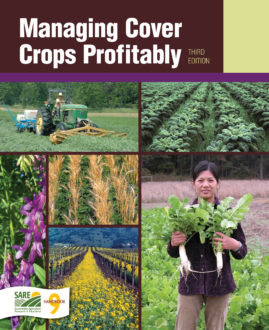Cover Crop Mixtures Expand Possibilities
Mixtures of two or more cover crops are often more effective than planting a single species. Cover crop mixtures offer the best of both worlds, combining the benefits of grasses and legumes, or using the different growth characteristics of several species to fit your needs.
You can use cover crop mixtures to improve:
- Winter survival
- Ground cover
- Use of solar energy
- Biomass and N production
- Weed control
- Duration of active growing period
- Range of beneficial insects attracted
- Tolerance of adverse conditions
- Forage options
- Response to variable soil traits
Disadvantages of cover crop mixtures may include:
- Higher seed cost
- Too much residue
- More complicated management
- Difficult to seed
Crop mixtures can reduce risk in cropping systems because each crop in the mix may respond differently to soil, pest and weather conditions. In forage or grazing systems, for example, a mix of rye, wheat and barley is more nutritious, can be grazed over a longer period of time and is less likely to be devastated by a single disease.
Using drought-tolerant plants in a perennial mix builds in persistence for dry years. Using a number of cover crops with “hard seed” that takes many months to germinate also improves coverage over a broader range of conditions.
Mixing cultivars of a single species with varied maturity dates and growth habits maintains optimum benefits for a longer time. Orchardists in California mix subclovers to keep weeds at bay all season. One cultivar comes on early, then dies back as two later cultivars—one tall and one short—come on strong. Because they reseed themselves, the cooperative trio persists year after year.
Sometimes you don’t know how much N may be left after cash crop harvest. Do you need a grass to scavenge leftover N, or a legume to provide fixed N? a grass/legume cover crop mixture adjusts to the amount of available soil N: If there is a lot of N, the grass dominates; if there is not much available soil N, the legume will tend to dominate a mixture. In either case, you get the combined benefit of N scavenging by the grass cover crop and N additions from the legume cover crop.
Mixing low-growing and taller crops, or fast-starting grasses and slow-developing legumes, usually provides better erosion control because more of the ground is covered. The vegetation intercepts more raindrops before they can dislodge soil particles. Sunlight is used more efficiently because light that passes through the tall crop is captured by the low-growing crop.
Adding grasses to a fall-seeded legume improves soil coverage over winter and increases the root mass to stabilize topsoil. A viny crop like vetch will climb a grass, so it can get more light and fix more N, or so it can be harvested more easily for seed. A faster-growing crop serves as a nurse crop for a slow-growing crop, while covering the ground quickly for erosion control. The possibilities are endless!
Mixtures can complicate management, however. For example:
- They may cost more to seed. Seeding rates for each component of the mix are usually lower than for sole-crop plantings, but the total seed cost may still be more.
- The best time to kill one crop may not be the best for another crop, so a compromise date may be used.
- If you use herbicides, your choices may be limited when you plant a mixture of legumes and nonlegumes.
- Sometimes you can end up with more residue than your equipment can handle.
The benefits of a mixture will usually outweigh these disadvantages, but you need to be prepared to manage the mixture carefully to prevent problems.
Each cover crop chapter gives examples of specific mixtures that have been tested and work well. Try some of the proven cover crop mixtures, and create your own tailor-made mixtures. Remember that adding another crop increases the diversity on your farm, and is likely to increase the many proven benefits of rotations over monocropping.
